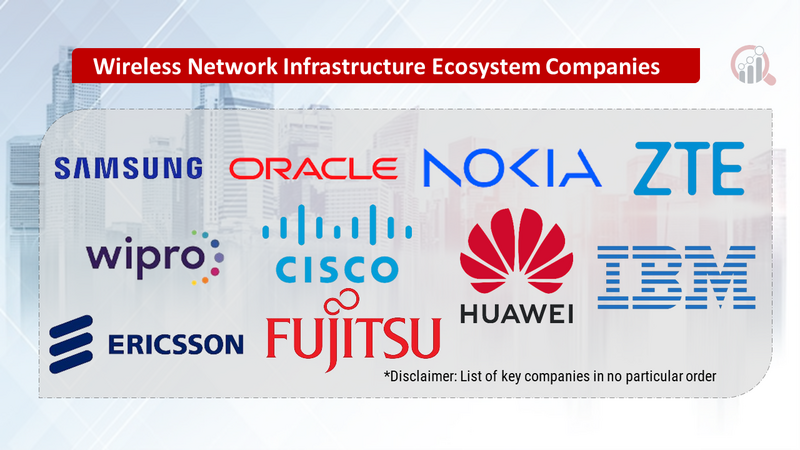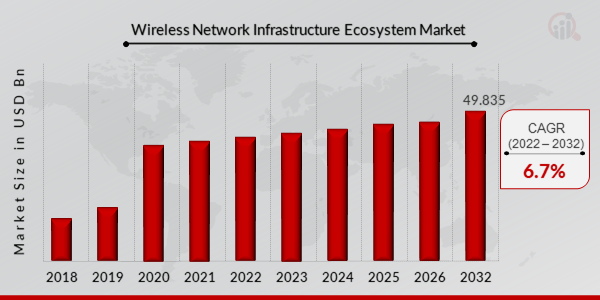
Competitive Landscape of the Wireless Network Infrastructure Ecosystem Market
The wireless network infrastructure ecosystem market is a dynamic and fast-growing space, driven by the increasing demand for data and the adoption of new technologies like 5G. This creates a competitive landscape where established players and emerging companies vie for Wireless network infrastructure ecosystem market share.
Key Players:
- Cisco Systems Inc. (US)
- Fujitsu (Japan)
- Huawei Technologies Co. Ltd (China)
- Nokia (Finland)
- Ericsson AB (Sweden)
- IBM Corporation (US)
- Wipro Limited (India)
- Oracle Corporation (US)
- Samsung (Korea)
- ZTE Corporation (China)
Strategies Adopted:
- Established players: Leveraging their existing market share, established players focus on research and development of advanced technologies like 5G, network slicing, and edge computing. They also emphasize expanding their service offerings to include managed services, network automation, and security solutions.
- Emerging players: Emerging players often focus on specific niche markets or technologies, offering competitive pricing and innovative solutions. They also prioritize partnerships and collaborations with established players to gain access to resources and market share.
Market Share Analysis Factors:
- Financial performance: Revenue, profitability, and market capitalization are key indicators of financial strength and market position.
- Product portfolio: Breadth and depth of product offerings across different technology segments, including 5G radio access networks, core networks, and backhaul solutions.
- Customer base: Number and type of customers served, including mobile network operators, enterprises, and government entities.
- Geographical reach: Global presence and market share in different regions.
- Technological innovation: Investment in research and development, patents held, and new product launches.
New and Emerging Companies:
- Airspan Networks: Focuses on open-source RAN solutions for rural and remote areas.
- CommScope: Offers a wide range of network infrastructure solutions, including fiber optic cables, antennas, and wireless backhaul systems.
- Cambium Networks: Provides wireless broadband solutions for enterprise and industrial applications.
- JMA Wireless: Specializes in tower and site solutions for wireless networks.
- Siklu Communication: Offers high-capacity millimeter wave technology for wireless backhaul applications.
Current Company Investment Trends:
- Increased focus on 5G: Companies are investing heavily in 5G research and development, both for hardware and software solutions.
- Network automation and virtualization: Companies are developing new solutions for automating network operations and virtualizing network functions to improve efficiency and reduce costs.
- Security and privacy: Companies are investing in security solutions to protect wireless networks from cyberattacks and comply with data privacy regulations.
- Open RAN: Companies are increasingly embracing open RAN solutions to promote interoperability and reduce vendor lock-in.
- Edge computing: Companies are developing edge computing solutions to bring processing power closer to the edge of the network, enabling real-time applications and reduced latency.
Latest Company Updates:
To speed up the monetization of operators' transport networks in the 5G future, NEC Corporation, and its ecosystem partners A10 Networks, Adtran (previously ADVA), Fortinet, and Juniper Networks introduced the Value Added xHaul Solution Suite in 2023. With the help of the new solution package, traditional IP and optical transport networking will be able to provide more value thanks to improved features including datacenter networks, network security, and automation that will increase operator profitability.
The 'Ericsson Reduced Capability (RedCap)' Radio Access Network (RAN) solution was introduced on Monday by Swedish telecom equipment manufacturer Ericsson in 2023. Its goal is to enable new 5G use cases for devices like wearables, industrial sensors, and smartwatches by increasing battery life and lowering complexity.
The Pi Network testnet now offers in-app notifications on the newest ecosystem items in 2023. In order to give users more detailed information about the most recent projects to launch on the chain, Pi Network (PI) has introduced a new feature to its ecosystem dashboard. Which third-party apps have been confirmed by Pi Network's core team and which have not yet been confirmed will be indicated by the update.
At the Mobile World Congress 2023, which will take place in Barcelona from February 27 to March 2, 2023, Astella Technologies Limited (Astella) will present a live demonstration of recently released commercial-grade 5G infrastructure software products, such as the 5G core network and 5G integrated small cells for both sub-6 and mmWave frequency bands.
Wireless Network Infrastructure Ecosystem Market Highlights:
Wireless Network Infrastructure Ecosystem Market Overview
According to Market Research Future, the wireless network infrastructure ecosystem market is expected to surpass USD 49.835 Billion by 2032 with a CAGR rate of 6.7% during the projected period. Everything that goes into making wireless internet function is referred to as the wireless network infrastructure ecosystem market. Items that assist in sending and receiving messages without the use of physical connections include routers, antennae, and other similar devices. It functions as the invisible crew that connects your devices to the internet wirelessly, eliminating the need for wires to obstruct your view.
Figure 1: Wireless Network Infrastructure Ecosystem Market Size, 2023-2032 (USD Billion)

Source: Secondary Research, Primary Research, MRFR Database and Analyst Review
North America is anticipated to lead the wireless network infrastructure ecosystem during the study period, followed by Europe owing to the increasing number of internet users and fast adoption of innovative technologies to improve efficiency and carry out day-to-day jobs in the North American countries such as US, Canada, and Mexico. The key drivers for the wireless network infrastructure ecosystem include the rising demand for high speed data connection and the growing adoption of smartphones. However, spectrum scarcity issue for commercial mobile radio frequency-based networks is an issue restraining the market growth. Moreover, the increasing use of voice over internet protocol (VoIP) technology, and video conferencing in Europe and North America have further increased the need for high-speed wireless data connection in businesses.
Wireless network infrastructure is the hardware and software resources of an entire network that enable network connectivity, communication, operations, and management of an enterprise network. It provides the communication path and services between users, processes, applications, services and external networks/the internet. The growing ownership of smartphones has led to a dramatic increase in Internet traffic. Smartphones are increasingly getting equipped to handle various applications for video streaming, mobile gaming, and video conferencing among others, which has further increased the requirement of high-speed data connection. The development of online applications such as navigation, online food delivery, media, and entertainment have led to a rapid increase in data traffic which has strained the mobile networks. Development of innovative solutions to fulfil the ever-growing data connection demands due to the increasing number of smartphone users is expected to drive the growth of wireless infrastructure ecosystem market during the forecast period.
Wireless Network Infrastructure Ecosystem
For the research study, the global wireless network infrastructure ecosystem market, by component has been segmented into hardware and software. The hardware segment includes small cell, macro cell, radio access network, distributed antenna system, backhaul, fronthaul, and remote radio head. Network function virtualization (NFV), operations support systems (OSS)/business support systems (BSS), software-defined networking (SDN), and others are included in the software segment. The hardware segment is anticipated to dominate the market during the forecast period whereas the software segment is expected to grow at the highest CAGR.
Regional Analysis
The wireless network infrastructure ecosystem market, by region, has been segmented into Asia-Pacific, North America, Europe, the Middle East & Africa, and South America. North America is anticipated to lead the wireless network infrastructure ecosystem during the study period, followed by Europe. In North America, the presence of key players in the wireless network infrastructure and the rising number of internet users are major driving factors for the growth of the market. The US dominates the market in North America accounting for the largest share, followed by Canada and Mexico. Europe holds the second largest market in the wireless network infrastructure ecosystem market. The UK is expected to gain the highest market share followed by Germany, France, and the rest of Europe during the forecast period.
Companies Covered
The key players of wireless network infrastructure ecosystem are,
-
-
Fujitsu (Japan)
-
Huawei Technologies Co., Ltd (China)
-
Nokia (Finland)
-
-
IBM Corporation (US)
-
-
Oracle Corporation (US)
-
Samsung (Korea)
-
ZTE Corporation (China)
Key Developments
- In May 2018, CommScope improved microwave antenna portfolio by introducing two new long-haul antenna product lines HX and USX into its Sentinel and ValuLine portfolios for next-generation wireless backhaul to improve the capacity, coverage, and cost of wireless backhaul for all applications.
- In May 2018, Qualcomm Technologies, Inc. introduced the first 5G NR solution that supports both sub-6GHz and mmWave Spectrum Bands for both remote radio heads (RRH) and small cells.
- In May 2018, Samsung collaborated with Verizon, a telecommunication company, and delivered equipment such as Baseband Units (BBUs) and Remote Radio Heads (RRHs) to improve the open, virtualized infrastructure model of the latter. Samsung assisted Verizon in enhancing their 4G LTE Open RAN initiative.
- In March 2018, ZTE Corporation and China Unicom, a telecommunication operator, collaborated to commercialize ZTE’s Magic Pole Small Cell Solution that features wireless backhaul, offering intelligent control of street lamps and minimize electricity cost.
- In March 2018, Huawei Technologies Co., Ltd. introduced innovative small cell product, 5G LampSite which is a multi-band indoor 5G small cell supporting both LTE and 5G.
Market Segmentation
By Component — Hardware(small cell, macro cell, radio access network, distributed antenna system, backhaul, fronthaul, and remote radio head) and Software(network function virtualization (NFV), operations support systems (OSS)/business support systems (BSS), software-defined networking (SDN), and others) By Connectivity Technology — 2G/3G, 4G, 5G
Wireless Network Infrastructure Ecosystem Market Highlights:
Leading companies partner with us for data-driven Insights
Kindly complete the form below to receive a free sample of this Report
























